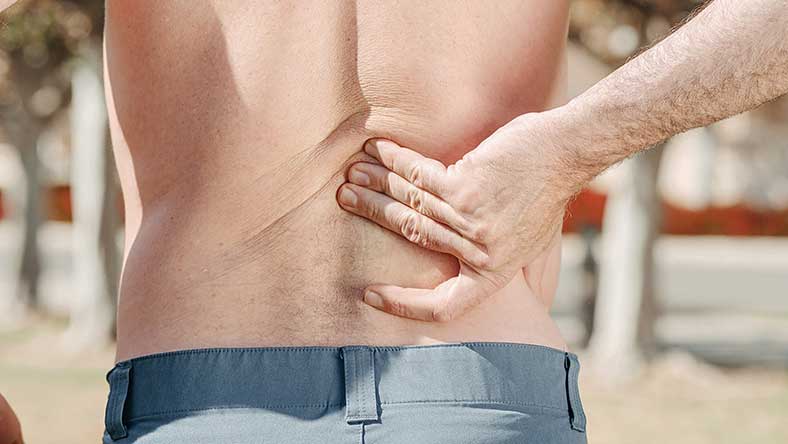
All about cystitis. How to treat and how not to treat cystitis!
18.12.2023BLOG OF DOCTOR SERGII LYULKO
RENAL COLIC
from first aid to an effective solution to the problem

Imagine this situation: another weekday is coming to an end. You've already finished work, reached home, ate, perhaps had a glass of wine or a glass of beer, lay down on the couch, went to YouTube or social networks / turned on the TV / continued watching the series. And here, something does not go according to the usual scenario.
You suddenly begin to feel some discomfort; it gradually turns into aching and then a very sharp pain. You change your position on the couch, hoping to find a place where the soreness goes away or weakens, but the pain does not become more manageable, but rather the opposite. There is a chill, bloating, and a pronounced feeling of weakness; you start to feel sick, vomiting is possible, but even after it does not get any easier, you often want to go to the toilet "in a small way."
What is it? The first thought coming to mindis that you ate something bad or the alcohol was not fresh. But this is not food poisoning. This pain is renal colic! So What kind of pain is it? What is all this for you, and what actions need to be taken in such a situation? Let's figure it out together.

RENAL COLIC: THE ESSENCE, CAUSES, AND MAIN SYMPTOMS
Renal colic is an acute pain attack, considered one of the most severe, intense, and pronounced. The resulting pain syndrome is impossible to endure, so in some cases a person may be in a state of shock.
You also need to understand that renal colic i s not a disease, but rather one of the main symptoms of a health-hazardous condition. Such a pain syndrome is a consequence of a disruption of the outflow of urine and, in most cases, indicates that a person has urolithiasis, or more precisely, that the movement (passage) of stones from the kidney into the ureter has begun.
How does renal colic occur? Sooner or later, the existing stone begins to move towards the ureters. Here it becomes a hindrance to the natural outflow of urine. Because of this, the kidney swells as the (intrarenal) pressure rises. Also, urine pressure leads to swelling. And since a slight possibility of stretching distinguishes the nerve receptors around the kidney, the person suffers from a severe pain attack.
According to various sources, renal colic occurs at least once in a lifetime in 1 - 12% of the world's population. More often, the problem occurs in men. Not only do urolithiasis and the passing of kidney stones can cause the corresponding pain syndrome. In approximately 13% of cases, they can be caused by other pathologies of the kidneys and urinary tract, namely:
- tuberculosis
- tumors
- dropsy of the kidney (hydronephrosis)
- congenital anomalies of the urinary tract structure (vassal conflict)
- Ormond's disease (retroperitoneal fibrosis).
In these cases, the lumen closure of the urinary tract also takes place, but not with stones, but with blood clots, mucus, pus, etc.
Renal colic is considered one of the most severe pain syndromes. It requires urgent care and treatment. Unfortunately, a person cannot find a place for himself, he is looking for a position in which the pain will not be so pronounced, but relief does not come. It is this behavior and the patient's complaints that often allow doctors to suggest colic even without examination, and so to speak "at a distance."
The onset of a severe lower back pain is often spontaneous. It can occur after shaking, driving, drinking alcohol, or simply drinking heavily.
Additional symptoms of renal colics include the following:
- other localization of pain. Pain can radiate to the groin, genitals, including the scrotum in men or the vagina in women
- increased pain when urinating
- staining of urine in pink and sometimes pronounced red. This pain occurs when the stone damages the cavity of the kidney or the walls of the ureter
- false urge to urinate and defecate
- a slight rise in body temperature (usually not higher than 37.5 degrees Celsius)
- slowing down the pulse
- pressure increase.
The pain does not go away from several hours to several days, and another attack may follow a short-term relief.
WHAT TO DO WITH RENAL COLIC? CALL AN AMBULANCE IMMEDIATELY.
Any severe deterioration of well-being is a reason for seeking emergency medical attention. renal colicsare no exception. If you suffer yourself or see someone else suffering, immediately call an ambulance. Unfortunately, the team does not always arrive in 10-15 minutes. There are traffic congestions in large cities or some places are far from any medical institutions. An additional negative factor is the Covid-19 epidemic, which increased the burden on the medical system as a whole.
In this regard, you need to understand what can and cannot be done while awaiting for an ambulance. Here are the main recommendations:
- complete rest is required
- it is also worth providing as much room for movement as possible since patients often cannot find any comfortable posture or body position
- if the patient can tolerate pain, it is better not to take painkillers. They can negatively affect the subsequent diagnosis;
- if you are sure that the matter is in stones (the patient has confirmed urolithiasis, this is not the first colic and stonepassing), and the body temperature has not risen, then it is permissible to use a hot bath to alleviate the pain. The water should be as hot as the person can handle.
Pay attention! Hot baths should be used with extreme caution and only taking into account other concomitant diseases. For example, for older people, this method of pain relief for renal colic is not suitable. Also, hot baths are not allowed for those who have suffered a heart attack or stroke. An alternative, in this case, can be mustard plasters or hot water bottles. They should be applied to the lower back, namely to the location of the kidneys.
When the pain is unbearable, then it is allowed to take two or three tablets of Drotaverin. Instead, you can also use Ketanov or Papaverine (one tablet) or any other antispasmodics. Intramuscular administration of drugs will allow increasing the effectiveness: painful sensations will decrease faster. If these drugs are not available, you can still take nitroglycerin (half a tablet under the tongue).
Anti-inflammatory non-steroidal drugs, for example, Diclofenac, also effectively relieve pain in renal colic. Intramuscular or rectal administration (in the form of suppositories) can be considered optimal.
Important! When using medications while waiting for an ambulance, you need to record all medicines taken. It is also recommended to control urine, namely, to monitor whether the stones have passed. Alternatively, you can collect it in a vessel. Even If the pain goes away, it is not recommended to cancel the arrival of the ambulance team. The attack may die out for a while due to the advancement of the stone but then return.
WHY SHOULD THE DESCRIBED METHODS OF PAIN RELIEF BE USED WITH EXTREME CAUTION?
Renal colic is most often a manifestation of urolithiasis. But its cause, as we have already said, maybe other pathologies. And renal colic can be similar in expressions to other diseases of the pelvic organs or abdominal cavity. At a minimum, it can be appendicitis, one of the prevalent causes of calling an ambulance.
If you think it is renal colic, but there are doubts (other symptoms), do nothing until the specialists arrive. So, taking antispasmodics or exposure to heat can be harmful in acute appendicitis or other inflammatory processes, which are also accompanied by the so-called "acute abdomen" and pain. Wait for doctors who, on the spot or already in the clinic, will exclude other pathologies, namely:
- appendicitis;
- cholelithiasis;
- stomach ulcer;
- ectopic pregnancy;
- ovarian cyst (and if it has already been diagnosed earlier, it is imperative to inform the ambulance doctors about it).
A topic for a separate discussion is renal colic in pregnant women. In this case, the pregnant woman must be treated in a hospital. Renal colic in its manifestations strongly resembles contractions, so any delay, in this case, is prohibited. You need to call a doctor right away. Even when you reach the hospital you should tell them about the pregnancy and the term. In this case, the brigade's arrival will be faster because there is a threat to the health and life of two people at once.
THE DIAGNOSIS OF RENAL COLIC IS MADE: WHAT’S NEXT?
A Doctor conducts an examination and diagnose and administer medications to provide relief from renal colic.
If the pain persists, then it is necessary to insist on hospitalization in the urology department. Why? Without ultrasound and blood tests, there is a chance of error - you may not have renal colic. Second, the urological department often represents large hospitals; there is surgery, gynecology, etc. If necessary, doctors will examine you there and will select the required treatment.
If first aid helped and the pain subsided or completely disappeared, then it's still too early to talk about solving the problem. It would be best if you still saw a urologist. After that, it is best to go to medical institutions and doctors who specialize in treating urolithiasis.
How do you choose an urologist who will help in this situation? Here are some basic guidelines for who to contact:
- it is right to visit a specialist who also specializes in the diagnosis of urolithiasis, including an ultrasound scan;
- the preferable option is to contact a urologist who has clinical experience in the endoscopic and minimally invasive treatment of urolithiasis;
- perfect if the clinic has modern equipment, including a laparoscopic stand, contact, and remote lithotripter.
We remind you that renal colic is not a disease but a manifestation of a violation of the outflow of urine, that is, "blockage" of the pathways through which it is excreted from the body. Urologists use the professional term obstruction of the urinary tract.
Obstruction is a dangegerous occurance phenomenon, the reasons for which must be identified. Otherwise, the person's condition will only get worse. An inflammatory process and the addition of a secondary infection will be added to the blockage. The body's degree of intoxication (poisoning) will also only increase, not to mention severe pain.
It is best to start treatment with the release of the upper urinary tract. And the faster, the better, because in this case, we can talk about an uncomplicated problem without developing an inflammatory process. But in practice, it is often very different.
HOW IS IT CUSTOMARY TO TREAT UROLITHIASIS?
The urologist who accepts patients at the clinic prescribes an ultrasound scan or laboratory research methods for renal colic. Ultrasound helps determine the stone's size and its position, the degree of "blockage" (obstruction) of the urinary tract, examines the test results and prescribes drug stone-expelling therapy.
According to the generally accepted approach in urology, stones up to 7 mm can break down on their own. Accordingly, if it is confirmed that their size in a particular patient is not more significant, then you can prescribe a standard treatment regimen and wait ... Wait until the stone comes out on its own.
No urologist can say precisely how long it will take. You have to wait several days, sometimes weeks or even more than a month. During this period, repeated attacks of renal colic with the same severe symptoms as described earlier are not excluded. The pain syndrome occurs because the ureter is up to 3 mm in diameter in its narrowest part, whilea stone’s diameter is likely more considerable, namely 5, 6, or 7 mm. In most cases, the stone will still come out. But there is no 100% guarantee. Plus, the time factor is also essential.
Foreign researchers have found that stones up to 5 mm in diameter leave the ureter on their own in 68% of cases and more those of more than 5 mm - in 47%. The timing also depends on their size. Small stones up to 2 mm come out on average in a month, from 2 to 4 mm - in 40 days, and from 4 to 6 mm - in 39 days. This is a very long time!
But urology is not standstill. Modern minimally invasive techniques are actively changing approaches to the treatment of urolithiasis. More and more urologists are confident that, regardless of the size and location of the stone, you can avoid anguish and long waiting for the patient to completely relieve himself and effectively help him get rid of the problem. And this approach is correct. Even small stones in the cups of the kidneys, which do not manifest themselves in any way, are best destroyed. This will eliminate the risk of their increase and the development of serious pathologies, including chronic pyelonephritis.
HOW TO GET RID OF STONES WITH UROLITHIASIS?
Distance lithotripsy (crushing) is considered one of the most effective low-traumatic methods of dealing with stones in the kidneys and ureters. The full name of the technique is extracorporeal shock wave lithotripsy (abbreviated ESWL).
With the help of special equipment (remote lithotripter), the destruction of stones is performed, which then naturally leave the human body. Focused high-intensity shockwave pulses cause fragmentation with a combination of ultra-low and ultra-high pressure waves. The effect can be compared with ordinary waves that diverge to the sides when something falls into the water.
Crushing is carried out in stages:
- first of all, the remote lithotripter destroys the upper layers of the stone (its dense frame);
- then the shock wave effect causes the formation of cracks;
- each next impulse makes cracks deeper;
- as a result, the stone breaks down into the tiniest fragments less than 3 mm in size;
- after that, tiny particles are naturally excreted from the human body.
X-ray allows determining the location of stones and focusing the impulse effect on them. In addition, on many modern remote lithotripters, ultrasound guidance can further increase the accuracy and efficiency of the procedure.
The advantages of ESWL in the treatment of urolithiasis include minimal trauma; as a result, the remote crushing procedure can be performed on an outpatient basis. In addition, many studies confirm that this method has numerous advantages over various surgical procedures, including open surgery and puncture percutaneous lithotripsy.
Stone size plays a crucial role in small crushing. The number of sessions required to destroy the stone into the tiniest fragments directly depends on this.
With an increase in calculi size, a decrease in the effectiveness of the first ESWL procedure is observed. So, if the dimensions do not exceed 9 mm, then in 4 cases out of 5, it is possible to get rid of them in one session of remote lithotripsy. However, in the presence of larger stones (up to 14 mm), the success rate of the first ESWL procedure is reduced to 64%.
There are studies that show that small crushing of kidney stones remains effective up to 15 mm, and in the ureters up to 10 mm. In addition, other factors must be considered in ESWL, including calculus density. Dense structures may not succumb to crushing from one session, which will require a second procedure.
Stones up to 10 mm in size, which have already ended up in the ureter and caused renal colic, are recommended to be broken up remotely immediately after diagnosis. The more effective ESWL will be. The patient will quickly feel relief and will be able to give birth to sand and small fragments without any problems and pain.
This position has been repeatedly confirmed in practice. Very often, patients literally "crawl" into the office with an attack of renal colic. During 10-15 minutes of examination (visual, palpation, and ultrasound diagnostics), the diagnosis of blockage of the ureter with a stone is confirmed. Then, another 40-45 minutes is spent on the remote breaking up procedure. And literally, an hour after resting in the ward of the day hospital, it seems as if a completely different person leaves the clinic - healthy and already rested, and most importantly - no stone at all and no complaints of pain. And this is just 2 hours.
WHEN CAN CONSERVATIVE STONE-EXORCISING TREATMENT BE DISPENSED?
Given the ability to solve emerging stones quickly and efficiently, waiting and using drug therapy is often wrong for the patient. In addition, without proper treatment, the risks of complications that urolithiasis entails increase. So, against the background of urinary tract obstruction, a decrease in renal function, the development of renal failure or organ death is possible.
It is permissible to do without extracorporeal lithotripsy or other methods of stone crushing in the following situations:
- there is a clear tendency towards the independent discharge of the stone. This is confirmed by the fact that the calculus is already in the first hours after the onset of colic in the mouth or lower third of the ureter. Ultrasound shows urine emissions (albeit weakened), and the size of the stone is less than 7 mm. With this development of events, the ultrasound scan must be repeated every other day, urine and blood tests must be done. ESWL is recommended if renal colic recurs, urine outflow or laboratory test deteriorates. If the patient's condition is satisfactory (repeated attacks do not occur), then it is recommended to wait up to a week, and if the stone itself does not come out, then perform remote or contact lithotripsy;
- a stone up to 7 mm in size is in the ureter, but it is technically impossible to break up it remotely. This happens if the calculus is not seen/ detectable on an ultrasound or X-ray. In this case, it is necessary to conduct an urography with contrast and ensure that the stone is streamlined. An ultrasound scan and a urine and blood test are recommended every three days. If the condition is satisfactory, then the waiting time for self-discharge should not exceed two weeks. In case of complications or if the calculus itself does not come out during this time, endoscopic surgery is recommended to remove the calculus or other surgical methods.
Today, extracorporeal lithotripsy has become the "gold standard" treatment for urolithiasis with small stones in the kidneys and ureters. This is primarily due to the vital advantages of this method, including low trauma, minimal risks of complications after ESWL, and, of course, high efficiency. Small crushing is carried out using local (less often intravenous) anesthesia outpatient (without hospitalization). The patient is in the clinic for 2-3 hours, after which he can return home.
In the medical center, remote and contact destruction of stones in the ureter and kidneys is successfully performed. For these purposes, highly efficient equipment of European production is used. Lithotripsy is performed by an experienced urological surgeon with 11 years of experience and regular practice performing minimally invasive urolithiasis treatment - Sergii Liulko.





